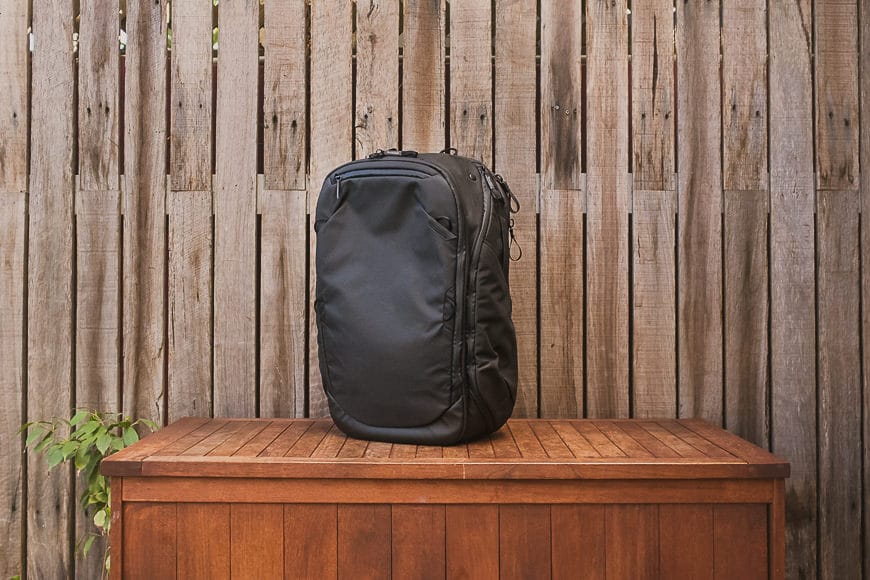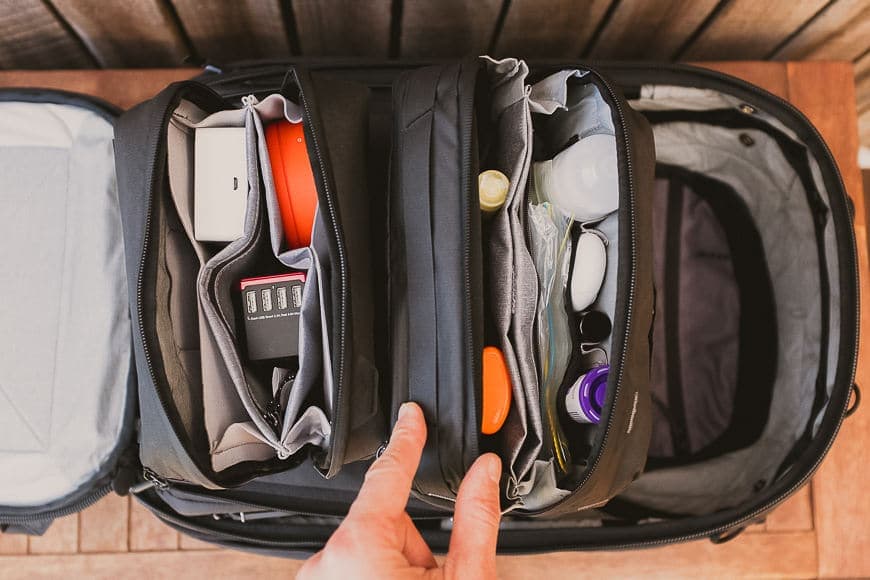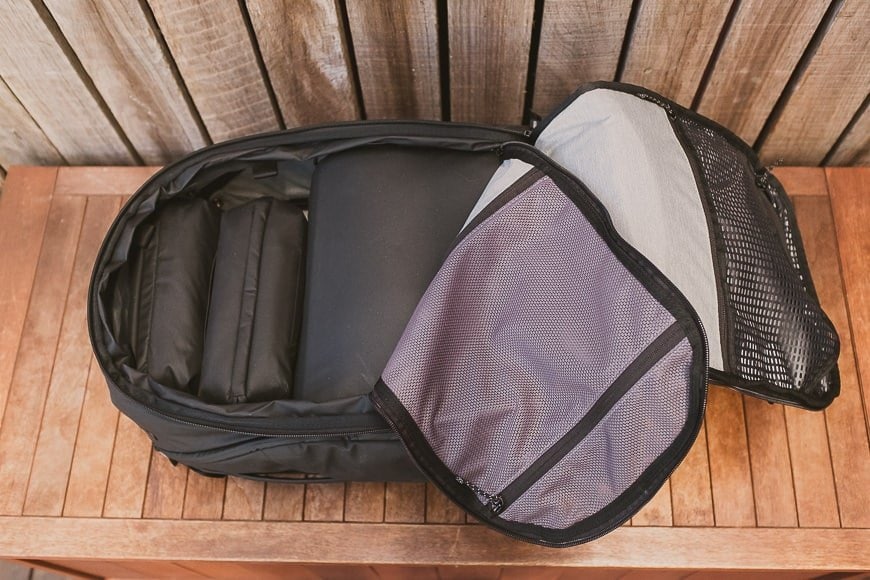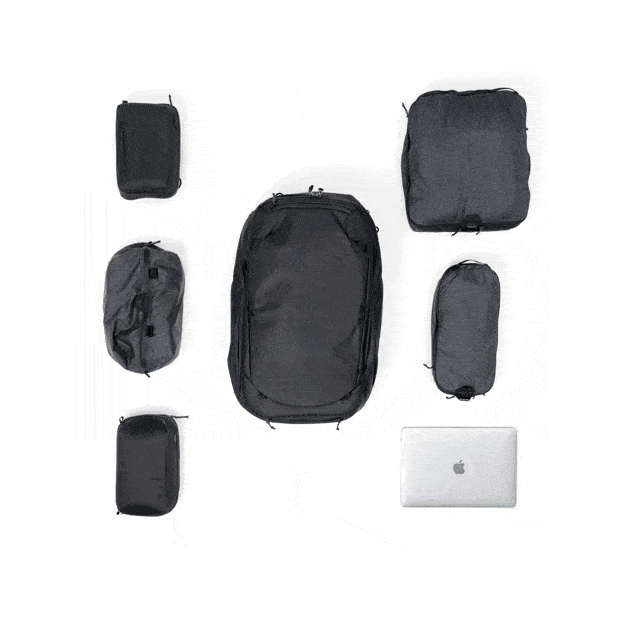
Peak Design Travel Backpack 45L Review
Read this Peak Design Travel Backpack Review for travelers and photographers needing an all in one system to carry gear and clothing efficiently.
Bag Reviews | Peak Design Bag Reviews | Photography Gear Reviews | By Mark Condon | Last Updated: May 26, 2023
I wrote this Peak Design Travel Backpack review a year ago, but have decided to update it for 2023 with some insights from my recent trips.
Peak Design is well known in the photography industry for creating bags that innovate in excel – we’ve reviewed almost all of them here on Shotkit.
Their foray into the travel industry was an eagerly anticipated one, and I was keen to get my hands on their new 45L camera backpack.

Functional, durable, comfortable... and uber cool! A truly unique camera backpack for travel.
My initial review was written after a couple of weeks of testing. It was, admittedly, rather harsh 😐
The Peak Design Travel Backpack deserves at least a year of consistent usage in order to form a balanced opinion – as you’ll see, there’s a lot more to it than meets the eye…
[Related: Mobile by Peak Design Review]Table of Contents
Peak Design Travel Backpack | Intro
Writing camera bag reviews is usually a rather simple affair. After all, a bag designed to carry a camera is usually much like any other bag, albeit one with some form of adjustable padding to safely transport photography gear.
Then there are bags like the Peak Design Travel Backpack that require a big step backwards, and a complete rethink of how to broach the topic.
To say that there’s a lot going on with the Peak Design Travel Backpack and the system of Packing Cubes is an understatement.
Luggage redefined: a carry-on Travel Backpack and system of Packing Tools designed around the idea that no two trips are the same.
There are literally so many features, so many nooks and crannies, and so many more large and small design details than you could shake a stick at – this review was a real challenge to put together!
Writing about every single one of the feaures of the bag would result in an enormous post, so I’ve decided to approach this review a little differently, and highlight what I like and dislike about the product.
Summary of Features
Watch the video above to see all the features of the Peak Design Travel Backpack, including practical usage cases.
Despite all the video reviews flying around online, Peak Design is obviously the best at showing exactly what this backpack is capable of in real-world situations.
As you’ve probably gathered, this is no ordinary camera backpack. It’s a complicated product with numerous features that require time to digest, and as such, is best explained in a video by its makers.
After you’ve watched the video, keep reading on to hear more about my favourite features, and those that left me feeling a little confused.
What I Like
-
Appearance

Size comparison – I’m 6ft 4″ (194cm)
While some brands choose to release a range of bags with different design elements to suit a range of people, Peak Design seems to prefer to try and offer one bag for everyone.
With the other bags in the line up, size is the only differentiator – you can have the Peak Design Sling, for example, in 5L or 10L variants.
With the Peak Design Travel Backpack, there’s only one size (45L), but a plethora of built-in storage/carry options designed to appeal to every sort of traveler/photographer.
45L is actually the expanded size of the backpack, with its regular size hovering around 35L, which is in my opinion the perfect size for a travel backpack. It’s also the maximum carry-on size of most airlines.
You can also ‘collapse’ the top third of the backpack, making it 35L and its appearance slightly less bulky. I think the aim here was to transform the bag into a more streamlined day pack, but in reality it doesn’t make that much difference.
The main thing I like about the design of the Peak Design Travel Backpack is how it looks. For all its bells and whistles, it still succeeds in looking understated and cool.

I usually opt for all-black bags, but the ‘Sage’ colourway looks great too!
I’m not a huge fan of the appearance of their previous creation, the Peak Design Everyday backpack, even though it’s a hugely popular product.
I much prefer the look of the Peak Design Travel Backpack in both black or ash, which manages to straddle both ‘tech’ with ‘stealth’, whilst still concealing an absolute tardis of internal carry/storage options.
The ‘Ash’ colourway deserves a special mention for being unlike any other bag I’ve owned – it really is a unique colour – kind of a mixture between grey and green, which is attractive and cool. I particularly like the brown leather branding accent on the front.
Recently, Peak Design have been releasing all-black versions of its Everyday line of bags, and I’m glad they went with two one-colour options with the Travel Backpack.
I’m also glad they resisted the temptation to bring other colours in to the various design elements, which may have resulted in a very ‘busy’ appearance.
-
Build

Camera cube featuring padded dividers can be accessed via the front flap or side flaps.
Looks are nothing unless they’re built on a solid foundation, and the Peak Design Travel Backpack doesn’t disappoint in this regard.
In fact, every Peak Design product I’ve handled has always featured premium build quality.
The more you use the Peak Design Travel Backpack, the more you’ll appreciate just how well it’s been put together.
The nylon shell looks and feels amazing in its matt finish, and coupled with its concealed padding, it’s built to protect your precious camera gear even if you’re forced to check-in the bag when traveling.
Available separately, the camera cubes add an additional layer of protection, whilst offering innovative side access points which mirror those found on the actual backpack, for ease of access without removing the bag from your shoulder.
As mentioned previously, the bag’s padding feels so robust so I’ve actually decided not to use the camera cube, with all my main gear items stowed away in the main flap’s zippered pockets.
Another example of the incredible build quality of the Peak Design Travel Backpack are the waterproof zippers, that slide solidly, but effortlessly around the inside and outside of the bag.
If you’ve ever wrestled with a zipper when it meets a curve, the operation of this bag will be a breath of fresh air. I also love how the zippers completely concealed when fastened, with the zipper pulls remaining large enough to grab even with gloved hands, but still not overwhelming in the bag’s overall appearance.
The zippers also offer multiple ways to secure the bag from pickpockets.
-
Storage

Modular Tech pouch (reviewed here) and Wash pouch (sold separately) feature numerous organisation options.
Once you’ve got over the sheer multitude of storage options available to you, and realise that you don’t need to use every single pocket and pouch, you’ll have a lot of fun loading and unloading the Peak Design Travel Backpack.
It feels a little strange initially to neglect certain storage options on the bag, but I believe this is essential to use it efficiently.
Leaving pockets completely empty and unused on the Peak Design Travel Backpack is OK! It may seem strange, but really, let go…!
Peak Design has given you the luxury of choice when it comes to loading your perfect travel backpack. This is a great thing, as long as you’re not wasting time looking for items every time you need to use them.
The storage options I liked in particular on this bag were as follows:
- Side pockets – these expand to include water bottles or lightweight tripods, and include handy magnetic closures when storing smaller items. They’re also the perfect size to house the awesome Peak Design Travel Tripod.
- Internal Main Flap Zippered pockets – I use these to carry small travel cameras and lenses.
- Shoulder Straps stowaway – ingenious design which allows you to create a ‘clean’ duffel bag, with the shoulder straps concealed behind the magnetic rear panel.
- Belt Strap stowaway – as above, but for a belt strap for when you need the extra support.
- Belt Strap zipper pocket – useful for small items, meaning you don’t need to remove your backpack for access.
Shotkit being a site for photographers, I should also mention that that the camera cubes transform the Peak Design Travel Backpack into a fully-fledged camera backpack.
The cubes are available in 3 sizes, and mount securely to the inside of the Travel Backpack via removable clips. The side access points can be tucked away, allowing you to access camera gear from the outside of the backpack via a single zip.
Inside the camera cubes reside a selection of Peak Design’s origami-style dividers and other padded ones, allowing endless organization and customization.
The cubes are sturdily built and offer a lot of protection, almost as if they’re intended to be used on their own. I actually found that the padding of the Travel Backpack was substantial enough to not actually require a camera cube to protect my gear.
I imagine if you’re planning to check-in the backpack, using the camera cube would offer the most peace of mind for protection, but if the backpack is to be largely remaining on your back, it may not actually be necessary (from a protection point at least).
Either way, the camera cubes do provide additional organisation options for your gear, which can be very useful.
As for the tech pouch and wash pouch, they’re both impeccably built and designed, with a multitude of sleeves, pockets, nooks and crannies to organise all your bits and bobs and keep them protected.
I also like the compressible packing cubes and shoe pouch, which weigh next to nothing and help keep the miscellaneous clothing items organised in the backpack.
-
Access
Camera Cube can be accessed via side opening of Travel Backpack.When you’ve got over the (somewhat confusing) novelty of being able to access the contents of your bag via the front, the back, the sides and the top, you should decide on one or two access options that work best for you.
This goes back to the notion of decision-fatigue, whereby you’ll be forced to think every time you come to open the Peak Design Travel Backpack, since there are so many damn ways to get inside it!
Remember I mentioned muscle-memory? Well, I want to be at a point with this bag where my hands move without thought to exactly where my gear is located.
I’ve chosen to ignore the side entry points completely, choosing to favour front flap or rear panel access. If I need gear, I access via the front. If I need clothes etc., I access via the back.
Once you’ve decided on your access points, you can now enjoy one of the best-thought-out travel bags you’ll ever come across.
No matter which zipper you pull to get into the Peak Design Travel Backpack, you’ll be able to access the interior in a split-second, without tugging stubborn zippers back and forth, or scratching your arm trying to reach through small openings.
Pulling open the front flap or rear panel is a glorious experience, instantly revealing the entire contents of the interior main compartment (or zippered interior pockets, depending on how you have the backpack set up).
-
Carry

Padded rear panel conceals shoulder and hip straps.
With all these innovative design features, let’s not forget what a travel backpack needs to do well – be comfortable while you carry it.
Despite being heavier than other travel backpacks I’ve come across, all that is forgotten when you actually have the Peak Design Travel Backpack on your back – this thing feels great to carry.
The rear panel and shoulder straps are padded just enough for prolonged use, and the axial rivets that secure the straps to the top of the bag allow the straps to rotate freely as you move.
This small design addition results in a backpack that conforms to any shape and size of back, and makes the Peak Design Travel Backpack comfortable and enjoyable to carry.
The stowable waist straps are a great addition too, allowing you to tighten the backpack more securely to your body, to aid with weight distribution and reduce movement when walking or running. There’s also a basic sternum strap, to further reduce bag movement.
I also love the grab handles, which as you’d expect from such a multi-faceted product as this, are located on the top, sides, rear and bottom of the backpack! The back handle also doubles as a pass-through for rolling camera bags, which is a nice touch if you’re traveling with check-in luggage too.
Another ingenious design feature is the rear panel, which folds under itself for increased ventilation and comfort, by reducing the surface area on your back.
What I Dislike
-
Over-Design…?

Zippered dividing panel separates bag into 2 compartments, or stows away to create 1 large volume
Watching the video above, you’ll probably be excited about a camera backpack with so many features – several of which you’ve probably never seen on a bag before.
After all, I can’t name any travel backpack or camera bag which offers access from all 4 sides… well actually, 5 sides if you include the regular top access too.
I don’t think I’ve ever come across a bag with so many pockets, zips, straps and attachment points either.
In their own words, the Peak Design Travel Backpack is the result of “2-years of coffee fueled nights and a desire to make the best damn travel system on the market.”
Now imagine an experienced design team consisting of photographers and other creative professionals, with a proven track record of creating a line of truly innovative carrying products, having a 2 year long discussion about what to include in a travel/camera backpack… it’s inevitable they’d create a monster!
The Peak Design Travel Backpack is the first bag I’ve ever used that requires muscle memory!
Is this a bad thing? Well, yes and no. Yes perhaps, if it’s a backpack you’ll be rotating alongside several other bags, without devoting the necessary time to really get used to its multiple storage options – I wasn’t kidding about the muscle memory thing!

Side access point – 1 of 5 ways to get inside the Travel Backpack
…and no if the Peak Design Travel Backpack will be, as Peak Design intended, the only travel/camera backpack you’ll ever need.
By my counting, there are eleven pockets you could legitimately use to carry your passport. ELEVEN!
With this bag, you need to spend time deciding and memorising which pockets you’ll be using for each individual gear item… and never change them!
There’s the OCD part of me that loves being able to organise gear in a compartmentalized way, with a pocket for absolutely everything.
Then there’s the lazy part of me that’s most comfortable with simplicity. Up until now my travel backpack of choice had 3 pockets – one main one for clothes, one laptop sleeve, and one for small items such as passports.
In this I’d throw a camera bag insert, or just the camera gear wrapped up in my clothes. I’d always know where everything was without having to think.
With the myriad of carrying/storage options offered to you by the Peak Design Travel Backpack, you’ll either be excited or overwhelmed.
2023 UPDATE: After using this bag solidly for over a year, I’ve grown accustomed to the location of all the pockets, and have chosen to ignore those that aren’t practical for me. It’s nice to know that there are other storage options, if and when my gear changes.
-
Weight

Front organization panel with dedicated laptop/tablet sleeve opens to reveal main compartment, medium camera cube, wash pouch and tech pouch.
This was almost a deal-breaker for me. One of my bug-bears with camera bags has always been bags that are heavy even when they’re empty.
Camera gear is already heavy – why would we want to add to this burden by using a bag that’s heavy?!
Unfortunately, it’s usually the case that the best looking camera bags are heavier than their rivals. Bags like the Holdfast Roamographer (reviewed here) or the Wotancraft Commander (reviewed here) which wouldn’t look out of place on a catwalk are heavy, and that’s why I don’t use them.
As for a dedicated travel bag, well weight becomes even more important, especially if you travel a lot on stingy local airlines with measly carry on baggage limits (7kg in Australia).
Empty, it weighs in at 2190 g (4.8 lbs). Coupled with the Medium Camera Cube which I imagine most photographers will go for, the combined weight is already 2930 g (6.5 lbs).
My goal is to always travel with just one single carry-on item, not only for fear of mislaid checked luggage, but also to do away with the time required waiting for luggage to arrive on the conveyor belt at the destination.
Ironically, the weight of the Peak Design Travel Backpack actually makes it a huge challenge for me to travel without checking in an additional bag.
Depending on your country and airlines, this may or may not be an issue for you, but I’d much prefer to be under the most stringent airline baggage allowances worldwide, for absolute peace of mind.
Pro travel tip for photographers: Over the carry on weight limit? Simply attach your flashes and lenses to your camera bodies and carry them via a strap on your shoulders when checking in. It’s a bit cheeky, but these items won’t count towards your carry on luggage weight.
[Related: travel tips for photographers.]
Fortunately, I use a mirrorless camera system and a couple of small, lightweight flashes and lenses (see my Sony accessories guide), so shave off a lot of weight in that regard.
However, traveling with the Peak Design Travel Backpack has required a complete rethink of my packing options.
2023 UPDATE: I’ve been traveling carry-on-only with this bag for a year now. Yes, it’s been a challenge on regional planes with stingy baggage allowances, but it has been possible with a little ‘rejigging’ of my gear.
To say that the weight of the Peak Design Travel Backpack is a disappointment to me is an understatement, but I’m willing to make the sacrifice and use this bag over my previous light-weight travel bag for two reasons.
First, protection. Made from recycled plastics, the 400d nylon canvas shell and 900d bottom is weatherproof and extremely durable. The exterior is padded to the extent that I don’t feel I actually need to use the bulky camera cube at all, which shaves off some extra weight to my set up.
The second reason is that I’ve grown to like the wealth of features, which no doubt add to the weight.
Yes, I believe it’s somewhat excessive to have so many carry/storage options, but it’s also great to have a place for each gear item, once you’ve spent the time memorising the location of everything.
Thanks to the exterior padding and multiple zipped pockets on the interior, I’m currently experimenting with my camera body plus two lenses in one pocket, and my 2 flashes and trigger in another – a second zippered flap ensures that my gear is suspended above the main carry compartment.
For those with bulkier DSLR set ups, my pocketed-approach to gear storage to free up the main compartment won’t be possible, in which case you’ll need to resort to the camera cubes, or my recommendation for lighter weight – Domke protective velcro wraps.
It’s also worth noting that if you want a camera backpack with a similar level of robustness and features, it’ll also be as heavy as this one – case in point, the McKinnon x Nomatic Camera Pack, which weighs in at a portly 3kg (6.6lbs) unpacked!
Value for Money + Cost

Despite so many innovative features, the Peak Design Travel Backpack manages to remain understated in its appearance.
So for such a well-thought-out, well-designed backpack, what’s the damage?!
It’s obvious that for this level of quality, you’re going to be looking at pricing that’s above average for a travel backpack, but Peak Design has still managed to keep it competitive when compared to other models by competing brands.
45L Travel Backpack
MSRP: $299.95
The various modular packing cubes are sold separately here, giving you the option to pick and create your own individual bag set up to suit your needs.
Compressible Packing Cubes
MSRP: Sm – $29.95, Md – $39.95
Wash Pouch
MSRP: $59.95
Tech Pouch
MSRP: $59.95
Camera Cubes
MSRP: Sm – $49.95, Md – $69.95, Lg – $89.95
Shoe Pouch
MSRP: $24.95
Rain Fly
MSRP: $29.95
All in all, I think the Travel Backpack and accessories are all excellent value for money, and a great investment for those who need a highly functional, good looking travel backpack that is built to last a lifetime
Frequently Asked Questions
Is the Peak Design backpack waterproof?
The Peak Design Travel Backpack is built for the elements. It has outer shell made from waterproof nylon canvas and double padding. The zippers are also waterproof.
How big is a 45l backpack?
A 45l bag is the most efficient use of most airlines’ carry-on luggage allowance. A bag measuring 22″ x 14″ x 9″ is 2,772 cubic inches in volume, which equates to 45.2l.
How do I clean my Peak Design bag?
Most dirt can be easily removed using a damp washcloth. The Peak Design Travel Backpack is treated with anti-absorbtion agents, meaning that most stains don’t penetrate very deep. If the stain/order is still present after the first rinse, repeat the hand wash, and gently scrub it with a soft-bristled brush. Rinse and repeat as necessary. Then let the bag fully dry in a well-ventilated area.
Peak Design Travel Backpack | Conclusion

So as you can see, there’s a lot to like about the Peak Design Travel Backpack…
It’s hard to please everyone with the release of a product, but Peak Design has certainly tried to do exactly that with the Travel Backpack.
I love the modular approach, which attempts to simplify travel via the use of dedicated pouches for tech, toiletries and clothing.
Initially I was overwhelmed by the multiple carry and storage options of this backpack, and part of me wishes that they’d neglected some of them, which may have resulted in a lighter product.
However, I’m willing to sacrifice my lighter travel bags for the minor additional weight of the Peak Design Travel Backpack, and what I’m left with is a truly innovative product which is a genuine joy to use.
Congratulations Peak Design for continuing to push the boundaries of what’s possible in bag design, and in doing so, making one-bag-travel more convenient, secure and fun.

Functional, durable, comfortable... and uber cool! A truly unique camera backpack for travel.















